IDEX Online Research: Retail Jewelry Prices Bouncing Around; Wholesale Jewelry Prices Steady
February 29, 12
(IDEX Online) – While jewelry wholesale prices have remained relatively stable for the past five months, retail jewelry prices have been like a bouncing basketball: up one month and down the next.
January retail jewelry prices rose sharply, after slipping in December 2011. Despite reasonably solid consumer demand in the all-important 2011 Holiday Selling Period of November and December, some jewelers apparently increased their level of price discounting in the two weeks prior to Christmas in response to a temporary lull in sales. In January, jewelers reversed themselves, and discounting diminished, pushing overall jewelry prices higher.
Further, the chasm between jewelry retail prices and jewelry supplier prices closed modestly in January, as retail jewelers implemented higher retail prices in an effort to restore their margins. Many jewelers are on a fiscal year ending in January; their price action in January may have been their final effort to boost margins for the year.
In January, the Jewelry Producer Price Index (JPPI) stood at 213.0 versus December’s 213.6; a year ago, the JPPI stood at 185.2. Here’s what this means:
· Wholesale jewelry prices fell by about 0.3 percent on a month-to-month comparison basis.
· Wholesale jewelry prices rose in January by about 15.0 percent on a year-to-year comparison basis.
· The JPPI was 100 in 1982, the “base” year. Therefore, suppliers’ jewelry prices today are more than double the level they were in 1982. They are up by about 2.7 percent annually, based on a compounded annual growth rate. Clearly, the current year’s inflation rate is dramatically above the thirty-year average.
· The graph below summarizes the JPPI over the past two years.
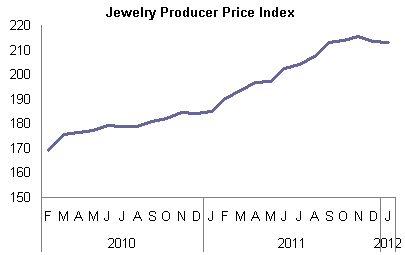 Source: BLS |
In January, the Jewelry Consumer Price Index (JCPI) stood at 169.3 versus December’s 165.0; a year ago, the JCPI stood at 158.4. Here’s what this means:
· Retail prices of jewelry rose in January by about 2.6 percent month-over-month.
· Retail jewelry prices rose by about 6.8 percent on a year-to-year comparison basis.
· The JCPI was 100 in 1986, the “base” year. Therefore, retailers’ jewelry prices today are up by roughly 69 percent in that twenty-five year period. They are up by about 2 percent annually, based on a compounded annual growth rate. Clearly, the current year’s inflation rate is dramatically above the twenty-five year average. It is also above the long-term JPPI growth rate, indicating that over the past two decades, retail jewelry prices have growth slightly more rapidly than supplier prices. Therefore, perhaps supplier prices are now “playing catch-up” in the current environment.
· The graph below summarizes the JCPI over the past two years.
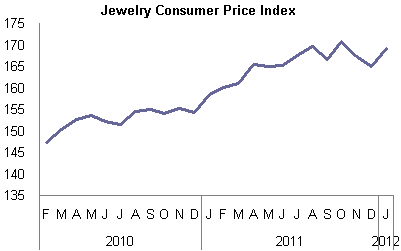 Source: BLS |
January Jewelry Price Inflation Remains High
While the January JPPI inflation rate was 15 percent, somewhat lower than prior months, it is still very high compared to historic levels in the low-to-mid single digit range.
Further, the January JCPI inflation rate of just under 7 percent, while more moderate than some months in 2011, is also running well ahead of its historic low-to-mid single digit level, similar to the JPPI.
The disparity between supplier price inflation and retail price inflation that characterized 2011 continued into 2012, though at a slightly lesser rate. Here’s how this disparity in inflation rates between producers and retailers affects the American jewelry industry: the margin squeeze that specialty retail jewelers have felt since 2009 continues to manifest itself.
While precious metal prices – gold, silver, platinum – seem more or less stable currently, they correlate somewhat to the global economic climate as well as to geopolitical uncertainties such as the current unrest in the
According to the latest forecasts from the OECD, the economies of most of the diamond-consuming countries are expected to grow only modestly in 2012. This could lead to further disparity between retail jewelry prices and supplier prices. If consumer demand weakens, retail jewelry prices will likely slip. However, when the global economy weakens, investors often buy gold as a safe harbor for their money; this will push the price of gold higher.
If gold prices start rising again, jewelry suppliers will have no choice but to raise their prices. This will intensify the current margin squeeze that retailers are experiencing.
The table below provides detailed inflation rates for jewelry components as well as inflation rates at various levels of the jewelry distribution channel in the
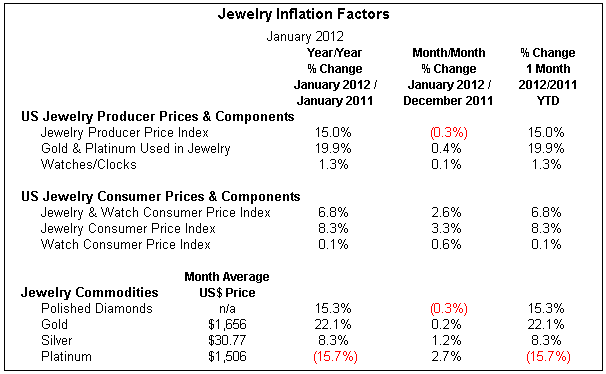 Source: Various markets |
Jewelry Suppliers’ Price Inflation Stable
On a month-to-month basis, jewelry suppliers’ prices appear to have been relatively stable for the past five months. The January JPPI index of 213 is in the range of the JPPI index for the past five months of 213 to 215.
January’s jewelry supplier price inflation rate of 15.0 percent, year-to-year, was modestly lower than the inflation rate in the second half of 2011, but it was higher than the inflation rate for 2011 of 13.3 percent. Further, it was nearly double the jewelry supplier inflation rate of 9.3 percent for the full year 2010, and it was multiples above 2009’s supplier inflation rate of 3.3 percent.
The graph below summarizes year-over-year jewelry supplier price inflation on a monthly basis.
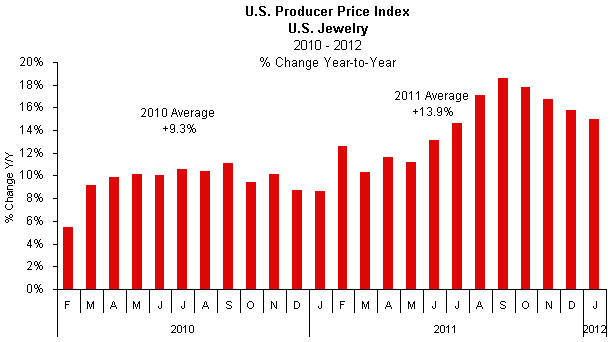 Source: BLS |
Higher Precious Metal Prices Continued to Drive Inflation Pace
Jewelry suppliers’ prices of precious metals jewelry rose by a dramatic 19.9 percent during January 2012 versus the same month a year ago. This was notably above jewelry suppliers’ overall inflation rate for all jewelry and watches of 15.0 percent for the month.
On a month-over-month basis, jewelry suppliers’ prices for precious metal jewelry rose by 2.6 percent in January versus December. On an annualized basis, this would suggest that suppliers’ jewelry prices could rise by 31 percent or so. These unrealistic monthly swings illustrate why IDEX Online Research does not put much emphasis on monthly price changes: they simply are not meaningful.
Why does month-to-month inflation of precious metal jewelry pause one month and spike the next month? While the economics of supply and demand have some impact on precious metals prices and inflation, the financial markets are responsible for most of the wild gyrations that affect precious metals prices.
The graph below compares the jewelry supplier inflation rate for precious metals jewelry (gold columns) versus the overall jewelry supplier inflation rate for jewelry (red columns). These comparisons are year-to-year.
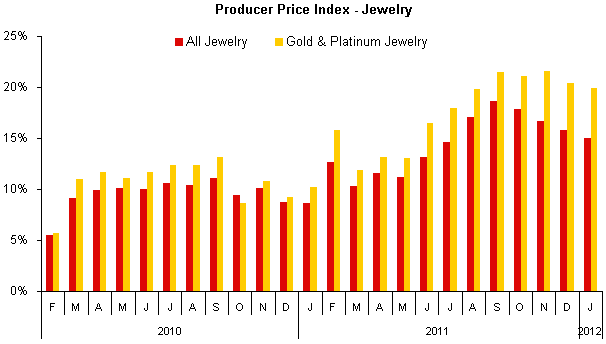 Source: BLS |
Watch Price Inflation Steady
Watch prices at the supplier level in January showed a miniscule gain of only 0.1 percent when compared to the same month a year ago. This level of inflation is reminiscent of inflation trends in late 2010 and early 2011, when watch prices rose by only ten to thirty basis points at the supplier level.
On a month-to-month basis – January 2012 versus December 2011 – supplier prices of watches were up 0.6 percent – about one-half of one percent.
In recent months, watch demand and watch sales in the
The graph below shows year-to-year supplier price inflation for watches for the past twenty-four months.
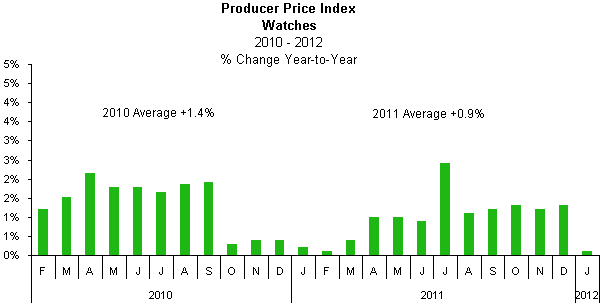 Source: BLS |
Jewelry Retail Prices Rise in January
Jewelry retail prices have been climbing since November 2010, driven by both stronger consumer demand and higher supplier prices. However, there have been month-to-month pauses in price increases along the way. After a pause in December, retail jewelry prices rose in January.
On a month-to-month basis, retail jewelry prices in January were up 2.6 percent, when compared to December 2011.
For the month of January 2012, retail jewelry prices – all categories of merchandise – rose by 6.8 percent over January 2011. This was a more modest increase than many prior months’ gains. It is important to note, however, that the use of the word “modest” for January’s +6.8 percent gain may be misleading: retail jewelry price inflation has averaged about +2 percent over the past 25 years since the BLS began keeping jewelry industry statistics.
The graph below summarizes year-to-year retail jewelry price inflation in the
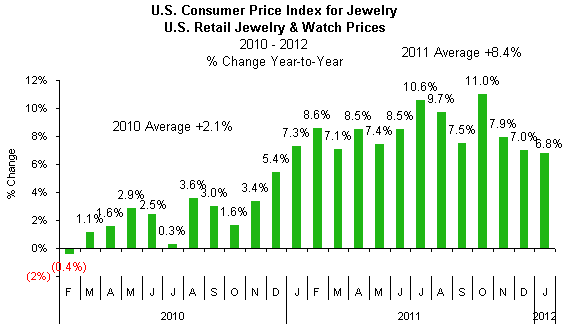 Source: BLS |
Watch Prices Show Very Modest Inflation
Retail and supplier prices of watches have tended to move together, both on a month-to-month basis and on a year-to-year basis, over the past few years.
For the month of January 2012, retail watch prices rose by a miniscule 0.1 percent from January 2011, an annualized rate of just 1.2 percent. That is about in line with last year’s retail watch price inflation rate of 1.5 percent. When compared to the prior month of December 2011, watch prices in January rose by 0.6 percent.
The graph below compares the inflation rate for jewelry and watches (green bars), jewelry only (red bars), and watches (gold bars).
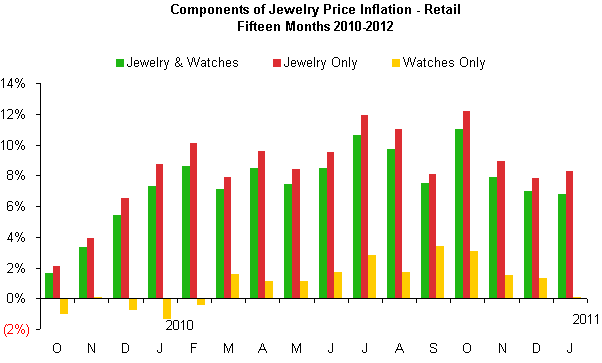 Source: BLS |
Jewelry Inflation Outlook: Uncertainty Near Term, Higher Long Term
Our outlook for jewelry price inflation remains unchanged: jewelry prices are expected to move higher at all levels of the distribution channel.
It would be easy to forecast inflation for the jewelry industry if all of the commodities involved in the forecast were used exclusively by the jewelry industry. While that may be the case for polished diamonds, precious metals are used by a number of other industries; further, gold is an international currency that plays in a financial arena of its own.
· Jewelry Industry Long Term Outlook – Demand from emerging economies such as
· Global Economic Outlook for 2012 – The latest OECD data points to moderate economic growth, which will likely hinder consumer demand near term.
· Financial Markets Outlook for 2012 – With continued volatility in the world’s stock markets and uncertain valuations related to stocks, bonds and other hard assets, investors are likely to move to the safe haven that gold offers.
The bottom line: inflation is headed higher over the longer term. Jewelry suppliers and retailers should use periods of weakness in commodity prices to add to their inventory.